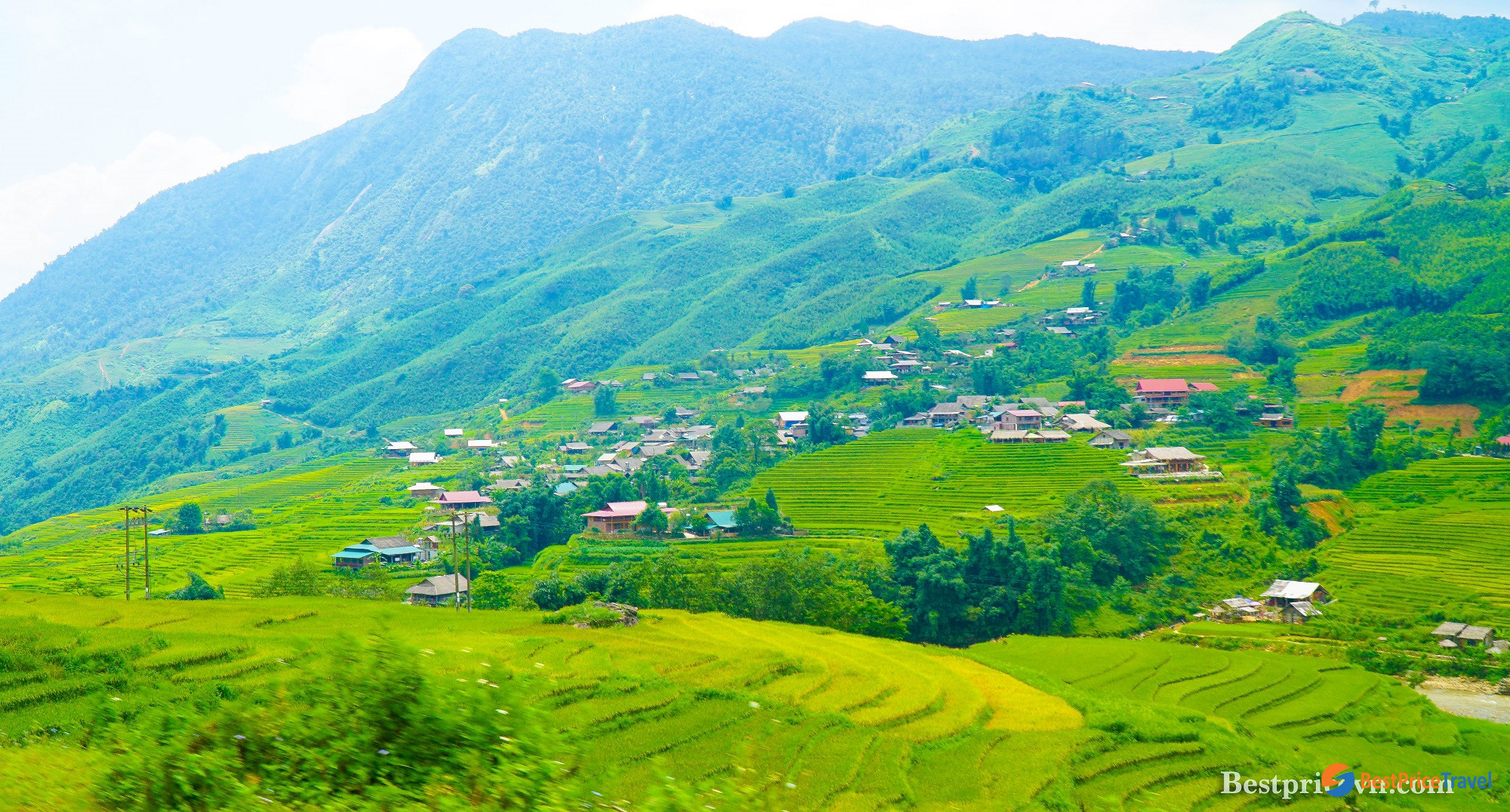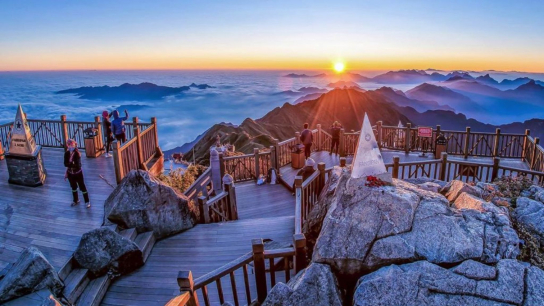Sapa Guide: City Of Cloud
Sapa is a mountainous town located in Lao Cai Province in the north of Vietnam, in close proximity to the Chinese border. Sapa town beautifully sits on a hill top at 1650 meters above sea level.
Thanks to its fascinating sceneries filled with rugged rice terraces, steep valleys, gorgeous mountain peaks, ancient ethnic villages, Sapa has long been an attractive spot welcoming tourists from all over the world. Coming to Sapa, travelers are not only exposed to spectacular nature view but also get the chance to experience ethnic local culture, which is highly interesting in terms of culture exchange and discovery.

Sapa trekking route
Being a frontier township of Lao Cao Province in Northwest Vietnam, Sapa was first inhabited by a group of ethnic people, whom experts thought to be present from the 15th century. Sapa came to the attention of the French in 1901 and located a military garrison here 2 years later. Their camp was named Sapa, after a nearby market.
When the French came in, all existing ethnic locals (mostly the Black H’Mong) was moved to resettle in Sin Chai village. It was not until 1906, when the railway line from Hanoi to Lao Cai was completed, some very first visitors began to arrive. The establishment of Cha Pa Hotel in 1909 marked the first milestone for Sapa tourism development. In 1913, a military sanatorium was also opened to treat sick expatriates who were believed to benefit from the fresh mountain atmosphere.
Sapa had been through sever damages from wars such as Viet Minh’s attack in February, 1947 or French’s command to bomb the town by air force in March 1952. Government offices, hotels, the French private villas were mostly destroyed. During the rough time, the remaining Vietnamese population could not return to their hometown until early 1960s, when the town began to develop once again.
Within 15 years changed rom a sleepy backwater into one of the busiest tourism hubs in Vietnam, Sapa has opened for foreign tourism from 1993 and continue to welcome tons of travelers from all over the world until present day.
Top Sapa attractions:
- Bac Ha Market: If you are the kind of exploring travelers, then Bac Ha Market is definitely your must-go checkpoint when visiting Sapa. Held only on every Sunday, Bac Ha Market is the biggest market of minority people in Northwest Vietnam. However, the distinctive market is famous for its primitive characteristics of traditional trading culture between different of minority groups, especially H’Mong and Dao people.

Bac Ha Market
- Fansipan Moutain Peak: Famous to be Indochina’s roof, conquering Fansipan peak is amazing experience that travellers should not miss. With the height of 3,143m, Sapa has the pride to have Mount Fansipan – the highest peak in Vietnam, Laos and Cambodia. Fortunately, climbing Fansipan is basic, there is no rough condition that requires ropes or technical climbing skills. Simply being spectacular, sunrise over Nothern Vietnam is definitely worth your time.
- Ta Van Village: Located at a mountain base, Ta Van Village is about 7km away from Sapa town. The village is hidden in the foogy cloud, with beautiful rice paddles and natural ecosystem. Offering spectacular landscapes and cultural experience, Ta Van Village is one neighborhood village that you don’t want to miss during your trip to Sapa. The best part of Ta Van trekking trip is probably the home cooked food coming straight off the homestay’s garden. All meals are fresh and tasty, not to mention their superb tasty complimentary drink – corn wine.
Sapa Culture:
Here is the home of both the Giay and the Black H’Mong individuals. In this village, travellers often feel welcomed from all houses of the hospitable people. The locals would love to help you learn about their culture and special customs, including some daily activities such as weaving fabric and textiles. To encourage the locals’ traditional craft, tourists are suggested to buy the products not only for their distinction and beauty but also the practically useful features, such as brocade scarves, embroidering cuíhions or ethnic instruments for souvenirs.
There are many ethnic traditional customs that could plus in your trip, from ancient customs like “pulling wife” (which a man can “kidnap” a girl to stay at his house for 3 days to decide if she wants to marry him) to interesting night life ike bamboo dancing, eating Thang Co (Sapa’s famous specially seasoned horse meat dish), ...
Weather in Sapa:
(How many season - Weather of each season - Which is the best time for traveling)
The best time to visit Lao Chai is from September to next April, when the village is decorated beautifully by the most wonderful rice terrace fields. Especially from September to mid-December, the weather is perfect for sight seeing and trekking trips.
Travelers are recommended to avoid visiting Sapa during June to September, when it is rainy and the road surface is slippery and dangerous to drive/ ride of trek.

Sapa Landscape
Transportation:
Most tourists come to Sapa from Hanoi by train or bus. It takes only about 5-6 hours by bus. But the paths are quite stiff, narrow and slippery, which can break your heart when drivers driving upwards. For a safer option, travellers may choose to travel by an 8-hour overnight train to Lao Cai train station. The train route between Hanoi and Sapa offers relatively comfortable sleeper cabins for you to relax before the wonderful journey.
From Lao Cai train station, it takes an hour to drive to Sapa town. Travellers can take a taxi to the town or reach right away to the preffered attraction.
Travel Tips:
- Trek with a trusted guide: Sapa tours include some interesting trekking trips that travelers are recommended to join. However, make sure you choose the right guide since he will decide and prepare all the route, meals, and resting spot, which mostly concludes your experience.
- Try not to ride motorbike: Sapa’s roads are narrow and slippery due to heavy fog. It takes locals to ride save instead of just an amateur rider.
- Don’t give children money: You are more likely to be accompanied by the ethnic children along your wander. You can reward them with pencils, books or clothes instead of money or candy, which discourage them going to school. This is like an unspoken rule.
- Money (Currency Exchange; where to change): Vietnamese official currency is Vietnam Dong. There are many Currency Exchange stations in tourists’ areas or city centers. You should exchange Vietnam Dong in Hanoi in prior coming to Sapa. Make sure you bring enough cash since ATMs are limited here.
Recommended Sapa Tours
-
 Highlights Sapa with Fansipan Mountain 2 days9.3Excellent - 2 reviewsSapa - Cat Cat Village - Sin Chai Village - Fansipan Mountain/pax
Highlights Sapa with Fansipan Mountain 2 days9.3Excellent - 2 reviewsSapa - Cat Cat Village - Sin Chai Village - Fansipan Mountain/pax -
 A Glimpse Of Sapa 2 days9.3Excellent - 11 reviewsSapa - Cat Cat Village - Lao Chai Village - Ta Van Village -…/pax
A Glimpse Of Sapa 2 days9.3Excellent - 11 reviewsSapa - Cat Cat Village - Lao Chai Village - Ta Van Village -…/pax -
 Sapa Trekking 2 days from Hanoi9.1Excellent - 27 reviewsHanoi - Sapa - Cat Cat Village - Y Linh Ho Village - Lao Chai…/pax
Sapa Trekking 2 days from Hanoi9.1Excellent - 27 reviewsHanoi - Sapa - Cat Cat Village - Y Linh Ho Village - Lao Chai…/pax



